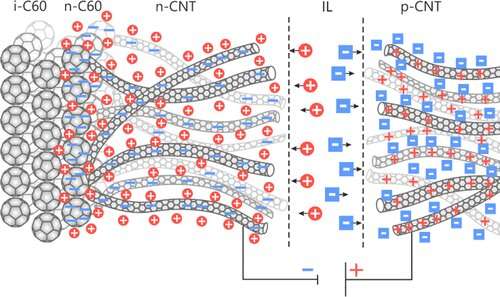Ionically gated small-molecule opv: interfacial doping of charge collector and transport layer. Credit: ACS Applied Materials & Interfaces (2021). DOI: 10.1021/acsami.0c17865
Physicists from ITMO University have discovered an accessible method that makes it possible to use transparent materials for solar cells while preserving their efficiency. The new technology is based on the method of doping—the modification of properties of materials by way of adding impurities—but without the use of expensive special-purpose equipment. Results of this research have been published in ACS Applied Materials & Interfaces.
One of the most intriguing challenges in solar energy is the development of transparent thin-film photoactive materials. Such film could be applied on top of regular windows to produce energy without affecting a building's external appearance. But it is quite difficult to develop solar cells that would combine high efficiency with good light transmittance.
"Regular thin-film solar cells have a non-transparent metal back contact that allows them to trap more light. Transparent solar cells use a light-permeating back electrode. In that case, some of the photons are inevitably lost when passing through, thus reducing the devices' performance. Besides, producing a back electrode with the right properties can be quite expensive," says Pavel Voroshilov, a researcher at ITMO University's Faculty of Physics and Engineering.
The issue of low efficiency is solved with the use of doping. But ensuring that the impurities are correctly applied onto the material requires complex approaches and expensive equipment. Researchers at ITMO University have suggested a cheaper technology for the creation of "invisible" solar panels—one that dopes materials using an ionic liquid that changes the properties of the processed layer.
"For our experiments, we took a solar cell based on small molecules and attached nanotubes to it. Next, we doped nanotubes using an ion gate. We also processed the transport layer, which is responsible for allowing a charge from the active layer to successfully reach the electrode. We were able to do this without vacuum chambers and working in ambient conditions. All we had to do was dribble some ionic liquid and apply a slight voltage in order to create the necessary properties," adds Pavel Voroshilov.
While testing their technology, the scientists were able to significantly boost the cell's efficiency. The researchers believe that the same technique could be used to improve the performance of other types of solar cells. Now, they plan to experiment with different materials and improve the doping technology itself.
More information: Danila S. Saranin et al. Ionically Gated Small-Molecule OPV: Interfacial Doping of Charge Collector and Transport Layer, ACS Applied Materials & Interfaces (2021). DOI: 10.1021/acsami.0c17865
Journal information: ACS Applied Materials and Interfaces
Provided by ITMO University
























